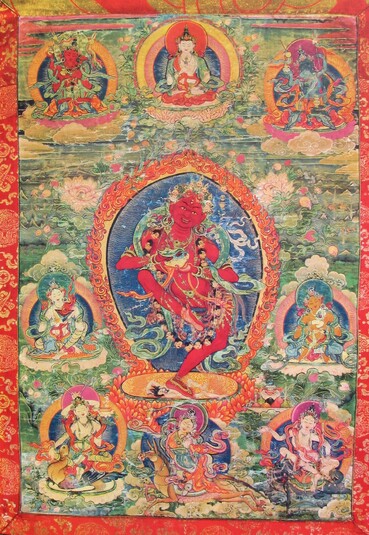
Item: Vajrayogini (Buddhist Deity) - Tinuma
| Origin Location | Tibet |
|---|---|
| Date Range | 1800 - 1899 |
| Lineages | Sakya and Buddhist |
| Material | Ground Mineral Pigment on Cotton |
| Collection | Private |
Classification: Deity
Appearance: Semi-Peaceful
Gender: Female
Summary: A minor form of Vajrayogini primarily associated with the Sakya Tradition.
Vajrayogini, Tinuma: belonging to the Chakrasamvara Cycle of Tantras, and in Tibet commonly associated with the 'Three Smaller Red Ones' from the collection of deities known in the Sakya Tradition of Tibetan Buddhism as the 'Thirteen Golden Dharmas.' (See Thirteen Golden Dharmas outline page). This is the last painting from a set of five or seven paintings in total. However, there is no apparent placement instructions or number on the back of the painting - likely rubbed off over time. No other compositions from this painting set are currently known.

Sanskrit: Vajrayogini Tibetan: Dor je nal jor ma
Tibetan: Dor je nal jor ma
...Devi Tinu, with a body red in colour, the right [hand] holds a curved knife aloft and the left a blood filled skullcup to the heart. The left leg is extended in a half posture dancing atop a lotus and moon." (Taranata, Rinjung. folio 437).
At the top center is the meditational deity of purification - Vajrasattva in solitary aspect. At the right and left sides are long-life deities. At the bottom center is a worldly protector deity. At the lower right and left are four figures of Tara from the group of Twenty-one Taras according to the system of Suryagupta.
At the middle left, holding a red triangular object, is Tara Burning Suffering. At the middle right, holding a vase, is Tara Giving Rise to Attainments. At the bottom left riding a bird is Tara Greatly Increasing. At the bottom right riding a buffalo is Tara Accomplishing the Complete perfection.
The painting was commissioned by Depa Rinpoche Tashi Kangsar and the verses of blessing on the back of the painting were put there by Tendzin Yeshe Lhundrub - possibly the artist.
The painting was owned by the Kumar family during part of the 1960s and in the early 1970s was photographed and used to make a full sized poster along with approximately ten other Tibetan paintings. These posters were quite popular and sold well in Europe and North America. The original paintings were eventually sold and some now reside in museums such as the Le Guimet in Paris and the Museum of Culture in Basel Switzerland.
Jeff Watt 7-2010
Reverse of Painting
English Translation of Inscription: [Extensive blessing and dedication on the back of the painting].
Buddhist Deity: Vajrayogini Main Page
Subject: Thirteen Golden Dharmas of Sakya
Buddhist Deity: Deities (Female)
Buddhist Deity: Tinuma (Vajrayogini) Main Page
Collection: Private 1
Buddhist Deity: Vajrayogini (Miscellaneous Masterworks)
Buddhist Deity: Tara (Suryagupta, Twenty-one as Minor Figures)
Subject: Tetrahedron (dharmakara/dharmadayo) Main Page
Buddhist Deity: Vajrayogini Iconography/Index of Names
Buddhist Deity: Vajrayogini (Miscellaneous Forms)









